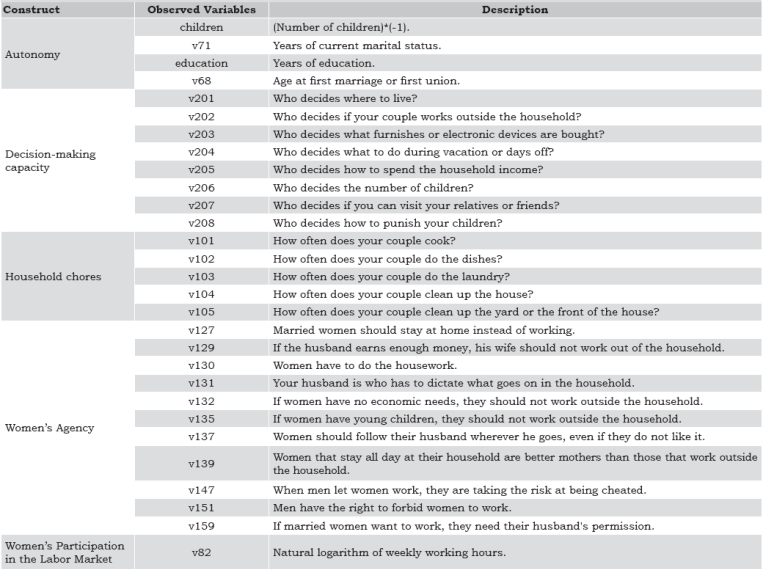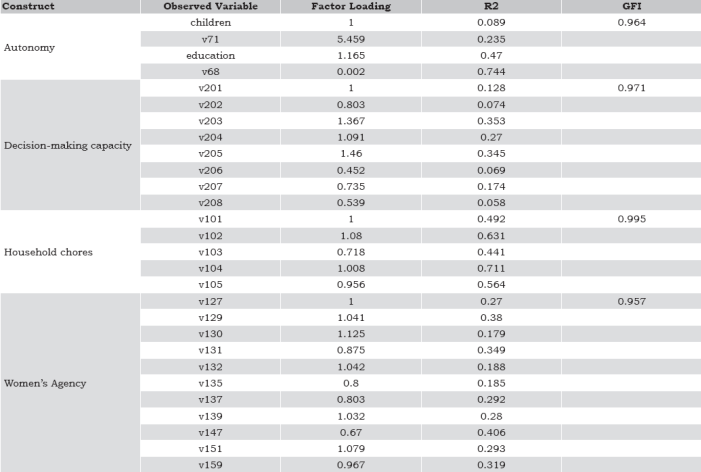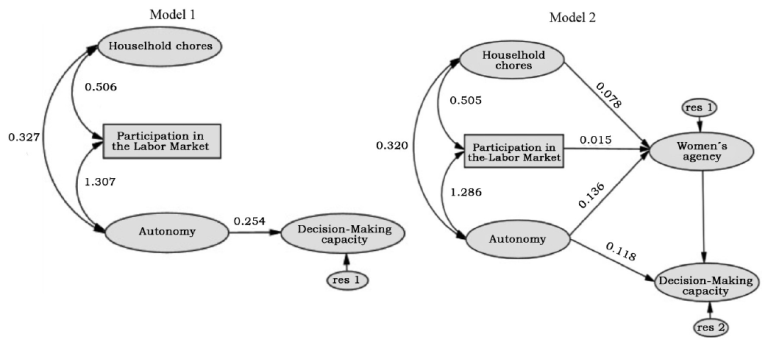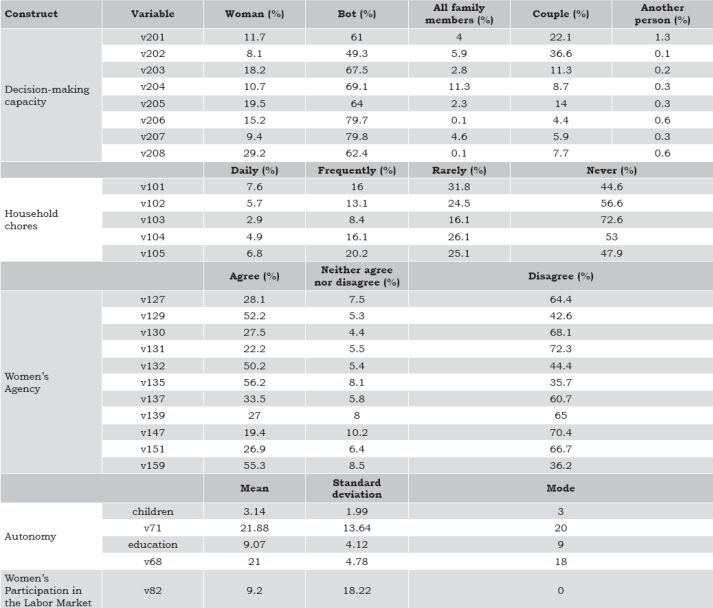Introduction
In many countries such as Mexico, many social programs have identified women as a key to success of social policies (Molyneux, 2006). Many of these programs empower women to improve their participation in decision making in both private and public spheres (Luccisano, 2004). But lack of women's status both at home and in public sphere has constrained efforts at enhancing their wellbeing (Luccisano, 2004, 2006). Women's capacity to make decisions especially on matters that influence their wellbeing is of central concern for the provision of social services as well as health care services (Casique, 2004). When women are unable to decide for themselves independently the scarce resources they need to promote their wellbeing such resources are likely to be underutilized (Gomes, 2013).
Concepts of autonomy and agency bear a close relationship with women’s decision-making capacity. Autonomy, agency, and women’s household decision-making capacity are dimensions centered on wellbeing concept (Sen, 2000). Although these notions are related to people’s wellbeing, they are conceptually dissimilar in terms of definition, temporality, and conditions, especially when they refer to women (Mishra & Tripathi, 2011). In spite of welldocumented dissimilarities at conceptual level, research on measurement of these concepts remain inadequate owing to difficulties in operationalizing terms empirically and securing reliable indicators to discriminate among interrelated concepts.
The purpose of this study is to identify a few correlates of women’s decision-making capacity in Nuevo Leon within households. The paper is organized under three sections. This section continues with a review of recent literature on women’s decision-making capacity, autonomy, and agency in developing countries and proposes a hypothetical model of selected correlates of women’s decision making in Nuevo Leon, Mexico. The second section presents data sources and results from test of hypothesized correlates of women’s decision making. Finally, last section discusses social contexts that promote women’s decision-making capacity.
Literature review and theoretical model
Although several definitions of autonomy exist, most refer to people’s resources to make decisions (Charrad, 2010; Howard-Hassmann, 2011). Hasselberger (2012) defines autonomy as a set of characteristics that give people the capacity to guide the course of their lives from their own point of view and interests. In this regard, autonomy refers solely to an individual-level disposition necessary for implementing strategies for attaining desired goals (Mishra & Tripathi, 2011). Autonomy brings people abilities to make the most from available opportunities (Mishra & Tripathi, 2011). Some authors consider autonomy to be a more static state than agency because the characteristics that may orient people’s actions are more stable or fixed over time (Allendorf, 2012; Casique, 2004; Mishra & Tripathi, 2011).
Several indicators are available to operationalize autonomy in empirical research. Street (2004), in a qualitative study, classifies women’s autonomy as a function of their level of participation in the labor market, possession of assets, and other factors such as education that increase female labor force. García (2003) utilizes different studies to design indicators of autonomy. Although she suggests that autonomy is usually measured through variables such as education level, labor situation, income, age, and age at marriage, she points out that improvements in these variables do not necessarily increase autonomy levels and that additional indicators should be considered to enhance the validity of a measure of autonomy.
Agency, on the other hand, is related to perceptions of possibilities for intensification as well as expansion of power to achieve desired goals and objectives (Mishra & Tripathi, 2011). The concept of agency denotes a process of change where people start becoming aware of their power, possibilities, and influences in different groups and environments. Individuals exercise and develop the use of their autonomy to change existing values and norms (Mishra & Tripathi, 2011). Women’s agency is the transformation of autonomy into intentions. In presence of agency, women “are able to define their self-interest and choice, and consider themselves as not only able, but entitled to make choices” (Mishra & Tripathi, 2011). Agency is a process through which attitudes generate a structure that guides future actions and constitutes people’s identity (Hasselberger, 2012). “An agent is autonomous when her behavior is motivated and guided by attitudes that posses authority” (Hasselberger, 2012). According to Kabeer (1999), measuring agency with explicit indicators turns out to be difficult because of its association with multiple social-psychological dimensions including decision-making processes, negotiation, deception, and manipulation.
But the transformation of autonomy into agency is influenced by specific social structural characteristics. Social structures define the extent and quality of women’s agency and outcomes (Charrad, 2010). Women exercise their autonomy within structures that may shape, constrain, or enhance their abilities. In turn, social structures embody power inequalities that influence agency. Many feminists have argued that the main source of power inequalities derives from existing patriarchal configurations in diverse realms such as family, the labor market, state, and religion (Charrad, 2010).
Moreover, process of exercising and developing use of autonomy leads to decision making. Once agency has been achieved, women are able to make decisions. Casique (2004) presents a scale to measure Mexican married women’s intrahousehold decision-making power through their decisions regarding the number of children they have, how to educate their children, daily expense, to visit their friends and relatives, and when to have sexual relations. Meanwhile, García (2003) suggests measuring women’s decision-making capacity within household through their level of participation in making decision regarding their children’s education and health care, use of birth control methods, and household expenditures. Bojorquez Chapela, Salgado-de Snyder & Casique (2009), assess women’s decision making in terms of their level of participation in decision making with respect to how much household spends on daily expenses, durable goods, and house improvements.
Within household, norms with regard to household division of labor influence the level of women’s decision-making capacity (Blair, 2013). As men actively participate in production of goods and services within household, men are more likely to partner with women improving women’s participation levels in decision-making (Acharya, Bell, Simkhada, Van Teijlingen & Regmi, 2010). Also, as women’s access to resources through labor force participation increases, their decision-making capacity is likely to increase (Fernández, 2010).
In sum, proposed correlates of women’s decisionmaking capacity are likely to include autonomy, agency, labor force participation, and amount of household chores (Soni-Sinha, 2011; Rajasingham-Senanayake, 2004) (figure 1). Both autonomy and agency affect women’s decision-making capacity. Women’s participation in labor market and spouses’ involvement in domestic work may shape women’s self conception and attitudes toward their role within as well outside household.
Methods
Based on this literature review, we hypothesize that women’s agency is a mediator between autonomy and decision-making capacity, and labor force participation has a strong association with these constructs. To test the mediator effect of agency, we estimate two structural models. In the first model, autonomy has only a direct effect on women’s decision-making capacity. Then, in model 2 we include agency as a mediator between autonomy and decision-making capacity. Figure 1 presents both hypothesized models in this study. The extent of involvement of spouses in domestic tasks and household chores is associated with the level of women’s burden when undertaking activities inside and outside household. Also, higher levels of women’s participation in labor market are correlated with their autonomy and spouses’ involvement in the domestic work.
Structural equation modeling approach is used to test women’s decision-making model in Nuevo Leon. A first step in this approach involves arriving at valid measures of all components concepts/constructs in the model. In order to test each component of hypothesized model presented in figure 1 and to ensure that all the latent variables are reliable and valid, each construct was evaluated separately using confirmatory factor analysis (CFA). Confirmatory factor analysis is used to develop measurement model. All measurement models were obtained by maximizing goodness of fit with help of modification indexes within limits of theoretical justification for altering their independent error structures. Most of the models were obtained by correlating at least two measurement errors based on modification indexes. Upon obtaining valid measures of all the constructs, structural equation model was used to assess hypothesized causality among latent factors.
Data
For this study, we use secondary data. Data for this study comes from the Survey for the Diagnosis of Families in Nuevo Leon, a state-level representative survey conducted by the School of Social Work and Human Development from Universidad Autónoma de Nuevo León (UANL) in 2010. The purpose of the survey was to obtain information regarding family dynamic. Survey consists of 2681 cases from 51 municipalities in Nuevo Leon. Sampling was based on results from the Second National Count of Population and Housing conducted by the National Institute of Statistics and Geography of Mexico. Stratified random sampling method was used to collect state-level representative data. Participants were comprised of male and female household heads older than 15 years old in any marital status (for more information see Ribeiro, 2011). In this study we use a sub-set of 1462 households with both partners present at the time of this study. A number of variables suffer from missing data. For variables with more than ten cases missing, we addressed the problem with mean imputation.
Operationalization of variables
Table 1 presents and describes operationalization of variables used to measure each of constructs in proposed model of women’s decision-making capacity. Previous studies suggest that decisions related to children’s education and health, household expenditures, women’s mobility, and sexual rights appear to indicate household decision-making capacity within Mexican context (Bojorquez-Chapela et al., 2009; Casique, 2004; García, 2003). In this study women’s decision-making capacity is measured through level of participation in making decision with regard to children’s education, number of children, location to live, expenses, and time allocation for recreational activities and to spend with friends and relatives.
Table 1 Description of variables and constructs.

Source: Survey for the Diagnosis of Families in Nuevo Leon, 2010.
Several indicators are available to operationalize autonomy in empirical research (Bojorquez-Chapela et al., 2009; García, 2003). To measure autonomy we utilize variables such as number of children, years of current marital status, years of education, age at first marriage. Agency is indicated by women’s opinion about their roles at the intrahousehold as well as extra-household level. Indicators include relationships of women to men.
Women’s participation in labor market is indicated by the number of hours that they work outside home. Regarding domestic tasks, women’s burden inside household may restrict their choices and opportunities to undertake activities in other spheres (Blair, 2013). We measure household chores using indicators that reflect women’s partner involvement in domestic work, such as how frequently couple do dishes, cook, or do laundry.
Analysis and Results
In average, women in our sample have 3.14 children, 9.07 years of education, and their first union was at 21 years old (appendix 1). Percentage of decisions that only women make within household ranges from 8.1% to 29.2%. The lowest percentage of decisions that only women make refers to living location and the highest participation of women in intra-household decisionmaking is related to children’s education. Regarding partners’ involvement in household chores, in most cases they never participate in domestic tasks.
Table 2 presents estimates from CFA models of four latent factors. Although squared multiple correlation value for a few indicators is less than 0.250, goodness of fit index (GFI) for the respective constructs suggests a high level of theoretical validity for each of the four constructs with all respective factor loadings significant at the 0.01 level.
Table 2 Loading factors, squared multiple correlation value and goodness of fit of the measurement model.

Note: All estimates are significant at the 0.01 level. Source: Own estimates with information from the Survey for the Diagnosis of Families in Nuevo Leon 2010.
Table 3 presents results from estimation of structural equation model for both models. Significant chisquare statistics indicates that reproduced covariance matrix differ from sample covariance matrix. However, given sensitivity of chi-square statistics to sample size and data that are nonnormally distributed, decisions on adequacy of a model should consider alternative indices of fit. The GFI, adjusted goodness of fit index (AGFI), and confirmatory fit index (CFI) values are close to 1 and Root Mean Square Error of Aproximation (RMSEA) is lower than 0.10, which suggest a good model fit. When incorporating agency as a mediator between autonomy and decision-making capacity the direct effect of autonomy on decision-making capacity decreases from 0.254 to 0.118. Increases in women’s agency lead to higher levels of their decision-making capacity. Furthermore, gains in agency have more impact on women’s decision-making capacity than increases in autonomy. This reveals importance of agency in the model as a relevant component in women’s decision-making capacity and as a process of change where women start becoming aware of their power, possibilities, and influence. Also, in model 2 the effect of autonomy on women’s agency is positive. As women’s autonomy increases by one unit, we find approximately 13.6 per unit increase in women’s agency level. Thus improvements in autonomy play a significant and effective role in promoting women’s agency. In presence of both autonomy and agency women are more likely to participate in decision-making actively.
Table 3 Coefficients and goodness of fit of the Structural Equation Model.

Note: All estimates are significant at the 0.01 level. Source: Own estimates with information from the Survey for the Diagnosis of Families in Nuevo Leon 2010.
As expected correlations among labor force participation, household chores, and autonomy are both positive and significant. Our results also suggest that women’s participation in labor market and men’s involvement in housework positively influence agency. Structural aspects have potential to either enhance or constrain autonomy and agency depending upon existing value structures. Our expectation that higher levels of women’s participation in the labor force and greater sharing of domestic tasks result in higher levels of women’s agency was supported. Both labor force participation and autonomy have a significant and positive indirect effect on women's decision-making capacity. The effect of autonomy on agency measured in terms of path coefficient is about nine times the path coefficient between labor force participation and agency. Subsequently, indirect effect of autonomy on decision-making capacity is both significant and stronger than indirect effect of labor force participation on decision-making capacity. Although all constructs in our model positively influence women’s decision-making capacity, results suggest that improvements in agency and autonomy levels contribute the most.
Discussion and conclusions
The aim of this study was to assess relationships between autonomy and agency along with their effects on women’s decision-making capacity in Nuevo Leon, Mexico. Effective exercise of women’s capabilities implies existence of freedom that allows women to pursue their desires and to choose among different available opportunities (Sen, 2000). In this paper we suggested that women's ability to participate actively in decisionmaking is determined by a set of background factors: labor force participation, husband’s participation in household chores, and autonomy through the level of women’s agency.
Significance of relationship between agency and women's household decision-making roles with respect to family matters in developing countries such as Mexico had not been adequately investigated (Casique, 2004; Wainerman, 2003). Impact of agency on decision-making does not occur in a social vacuum (Charrad, 2010). Thus, even when women possess skills and abilities to bring about change, these resources do not necessarily influence women's decision-making roles within family setting. In this regard, our study suggests that development of agency is crucial to success of projects and programs. Success of many public programs such as family planning depends upon women’s ability to make decisions within households (Gomes, 2013).
Even though literature on women’s decision-making underscores importance of direct effect of self-directed motivations, desires and autonomy, this study focused also on neglected indirect effect of autonomy on decision-making mediated by agency. We found indirect effect of autonomy on decision-making capacity to be significant, but lower when agency is considered. Direct impact of autonomy on decision-making capacity decreases from 0.254 to 0.118 when considering agency as a mediator. In general, our study finds that improvements in gender equality within household and development of agency can be achieved through different channels: promoting men’s involvement in housework, improving autonomy, and increasing women’s participation in labor market. Since the latent factor ‘autonomy’ was indicated by measures such as education level and number of children, improvements in these variables are likely to increase women’s agency. Improvements in education not only enhance women’s role inside and outside household, but also promote access to better job conditions (Pampel, 2011).
We found independent effect of labor force participation on women's agency to be significant and positive. At the policy level this suggests that programs on women's autonomy should be pursued along with side programs and policies to improve labor force participation. Women’s entry into labor market can be seen as an emancipating phenomenon that promotes equality between men and women. Through remunerated employment women are exposed to new interactions and are likely to redefine their roles (Fernández, 2013; Pampel, 2011). Their participation in labor force can modify their traditional practices as housewives and blur social aspects that confine them to domestic sphere (Colón-Warren, 2010). Factor 'household chores' was used as a control in our model. A challenge for future research is to assess translation of women’s participation in intra-household decision making into intended outcomes given their levels of autonomy, agency, domestic chores workload, and participation in labor market. Increases in men’s involvement in domestic sphere are likely to expand extra-domestic opportunities for women reinforcing their levels of autonomy and agency. Men’s involvement in domestic tasks creates a social environment conducive to improvements in women’s decision making.
Our results reveal the importance of considering influence of background factors when analyzing relationships between women’s agency and decisionmaking capacity. Although extra-domestic work may increase access to resources, family organization and dynamic are spheres that are slow to change and are accompanied by conflicting processes. In spite of expected resistance to change, increases in autonomy indicators and participation in labor market are likely to create social contexts that promote participation in decision making.
In spite of existing socio-cultural environment that limits women's autonomy and agency, we found significant effects of these factors on women's decision-making roles. Programs for improving autonomy and agency may provide a conducive environment for altering a socio-cultural environment that situates women in low status positions. Our study provides an empirical foundation for launching programs necessary to improve women's decisionmaking capacity.











 nova página do texto(beta)
nova página do texto(beta)




